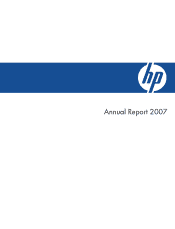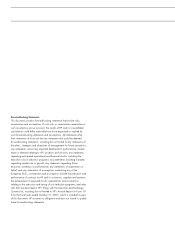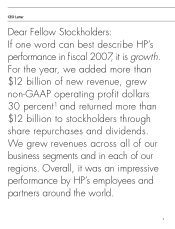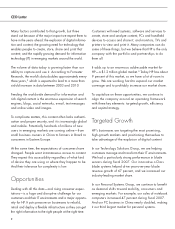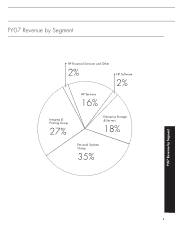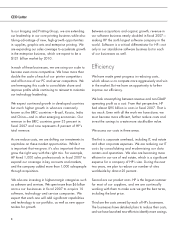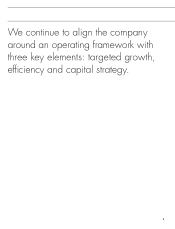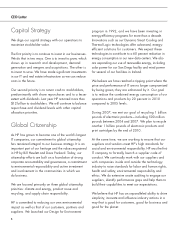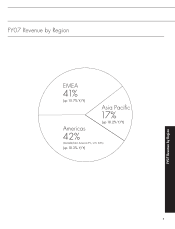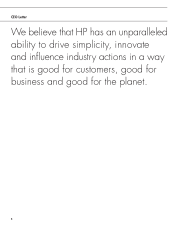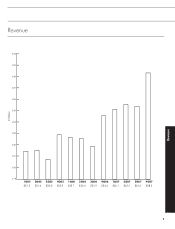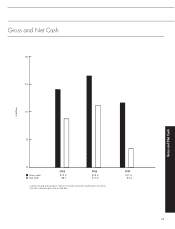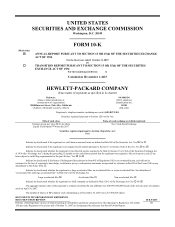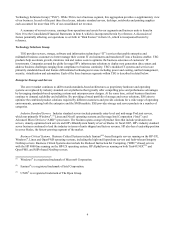HP 2007 Annual Report Download - page 8
Download and view the complete annual report
Please find page 8 of the 2007 HP annual report below. You can navigate through the pages in the report by either clicking on the pages listed below, or by using the keyword search tool below to find specific information within the annual report.
CEO Letter
Capital Strategy
We align our capital strategy with our operations to
maximize stockholder value.
The first priority is to continue to invest in our businesses.
We do that in two ways. One is to invest to grow, which
shows up in research and development, demand
generation and mergers and acquisitions. The other is
to invest to save. We have made significant investments
in our IT and real estate infrastructure so we can reduce
costs in the future.
Our second priority is to return cash to stockholders,
predominantly with share repurchases and to a lesser
extent with dividends. Last year HP returned more than
$12 billion to stockholders. We will continue to balance
repurchase and dividend levels with other capital
allocation priorities.
Global Citizenship
As HP has grown to become one of the world’s largest
IT companies, our commitment to global citizenship
has remained integral to our business strategy. It is an
important part of our heritage and the values engrained
in HP by Bill Hewlett and Dave Packard. Today, our
citizenship efforts are built on a foundation of strong
corporate accountability and governance, a commitment
to environmental responsibility and active investment
and involvement in the communities in which we
do business.
We are focused primarily on three global citizenship
priorities: climate and energy, product reuse and
recycling, and supply chain responsibility.
HP is committed to reducing our own environmental
impact as well as that of our customers, partners and
suppliers. We launched our Design for Environment
program in 1992, and we have been investing in
energy-efficiency programs for more than a decade.
Innovations such as our Dynamic Smart Cooling and
Thermal Logic technologies offer advanced, energy-
efficient solutions for customers. We expect these
technologies to contribute to a 60 percent reduction in
energy consumption in our new data centers. We also
are expanding our use of renewable energy, including
solar power for our San Diego facility and wind power
for several of our facilities in Ireland.
We believe we have reached a tipping point where the
price and performance of IT are no longer compromised
by being green; they are enhanced by it. Our goal
is to reduce the combined energy consumption of our
operations and products by 20 percent in 2010
compared to 2005 levels.
During 2007, we met our goal of recycling 1 billion
pounds of electronic products—including 500 million
pounds between 2004 and 2007. We plan to recycle
another 1 billion pounds of electronic products and
print cartridges by the end of 2010.
At the same time, we are working to ensure that our
suppliers and vendors meet HP’s high standards for
social and environmental responsibility. HP was the first
IT company to formally launch a supplier code of
conduct. We continually work with our suppliers and
with companies inside and outside the technology
industry to raise standards for labor and human rights,
health and safety, environmental responsibility and
ethics. We do extensive onsite auditing to engage our
suppliers, identify performance gaps and help them to
build their capabilities to meet our expectations.
We believe that HP has an unparalleled ability to drive
simplicity, innovate and influence industry actions in a
way that is good for customers, good for business and
good for the planet.
6

